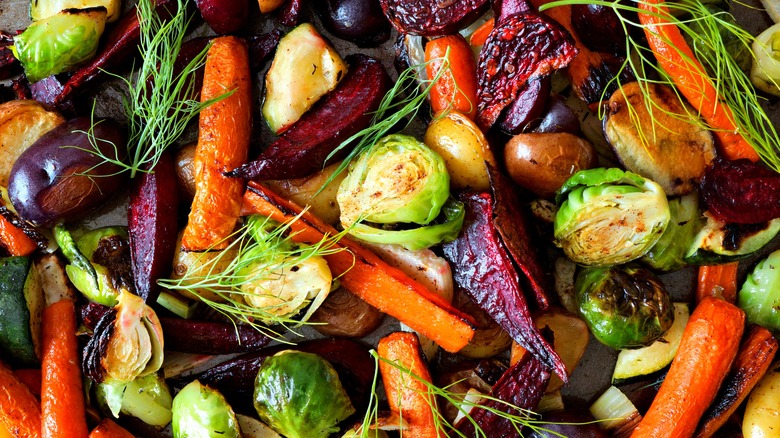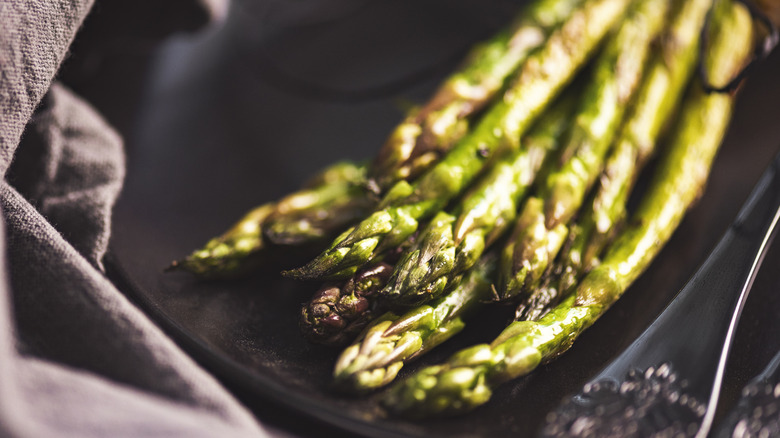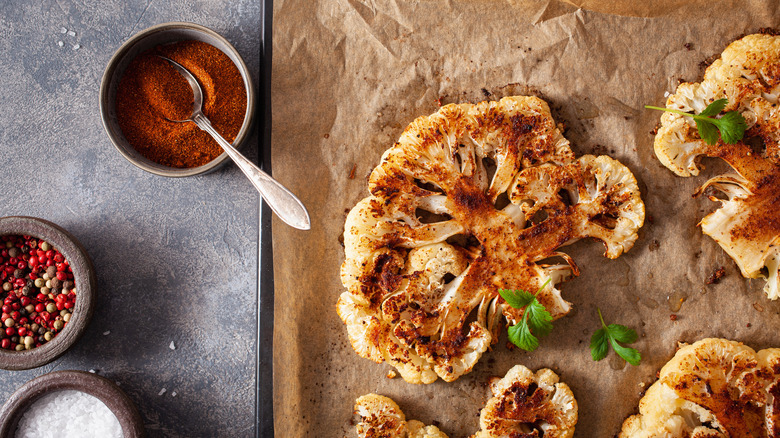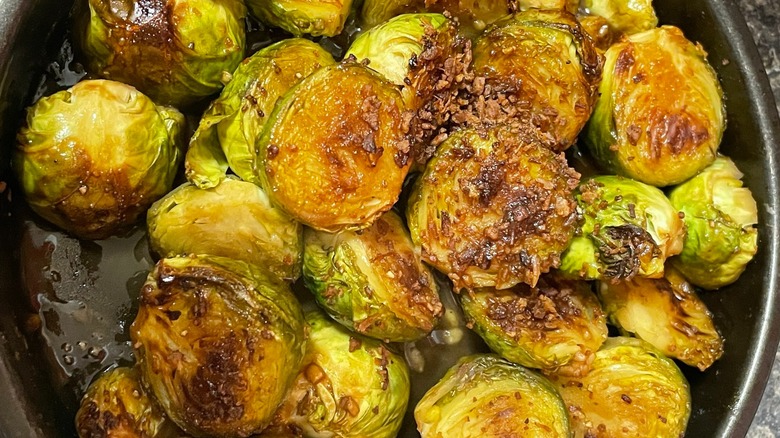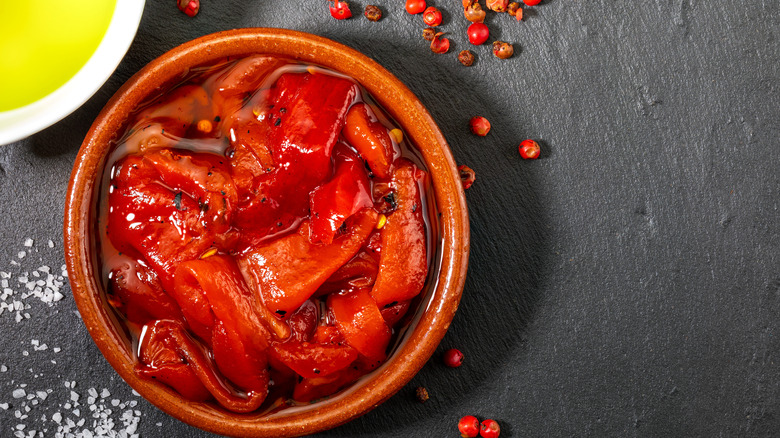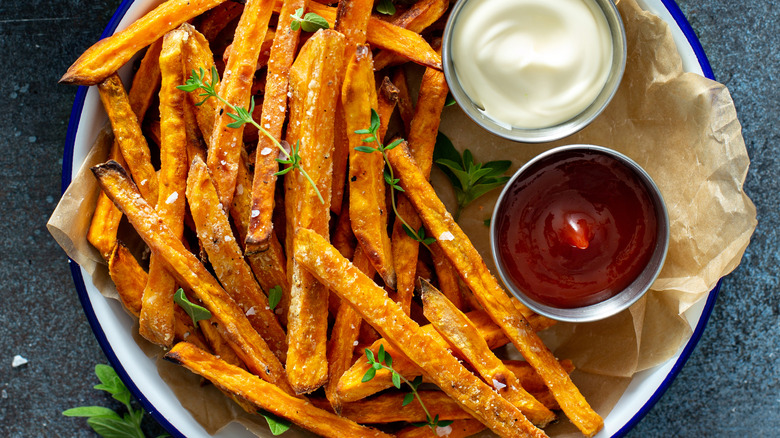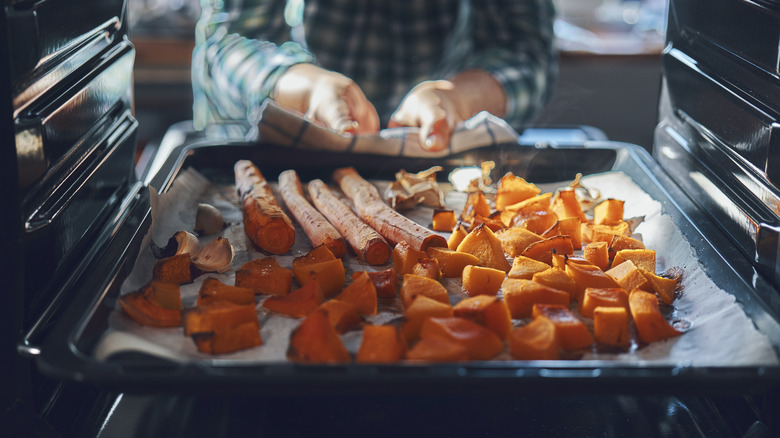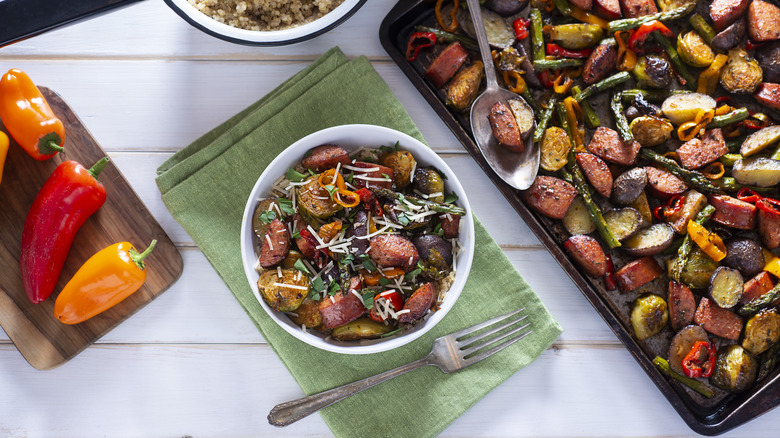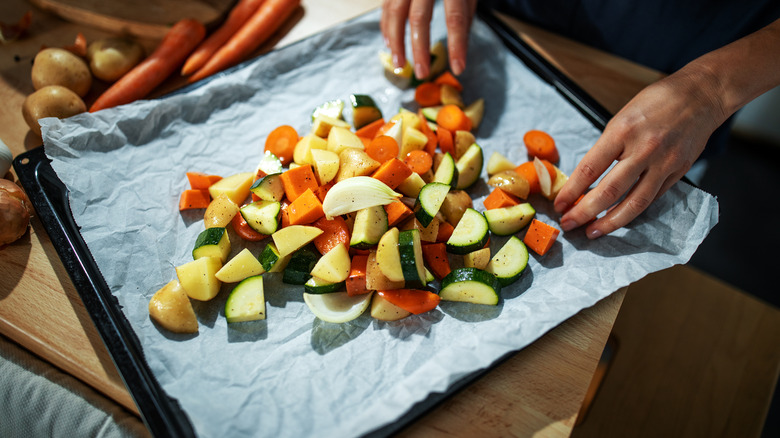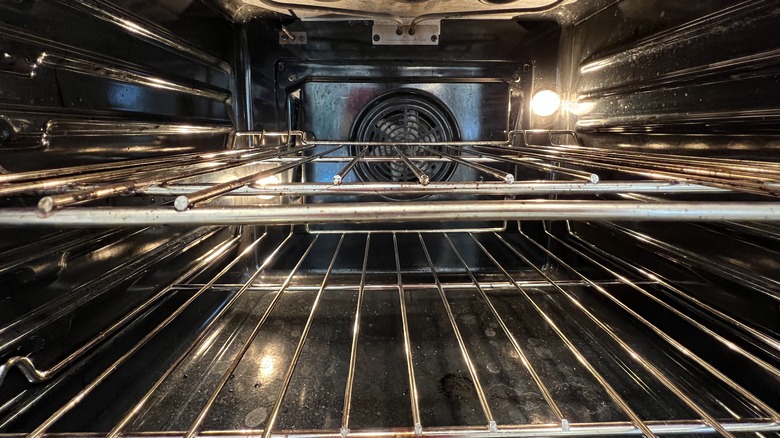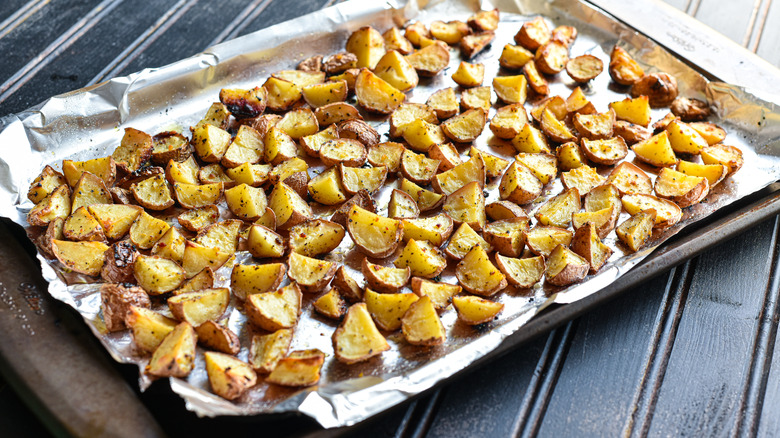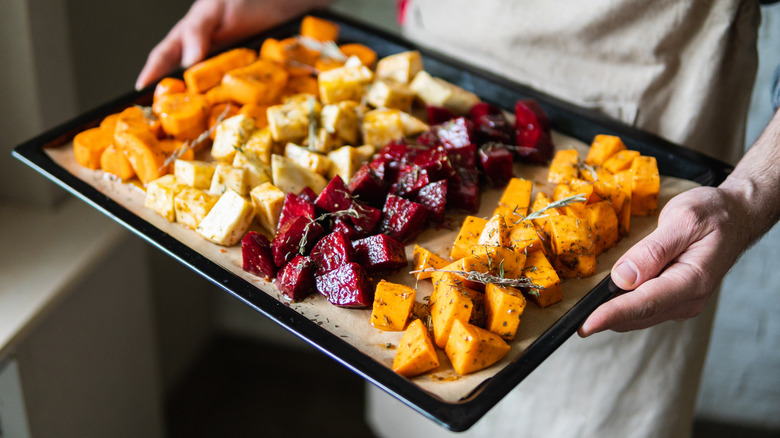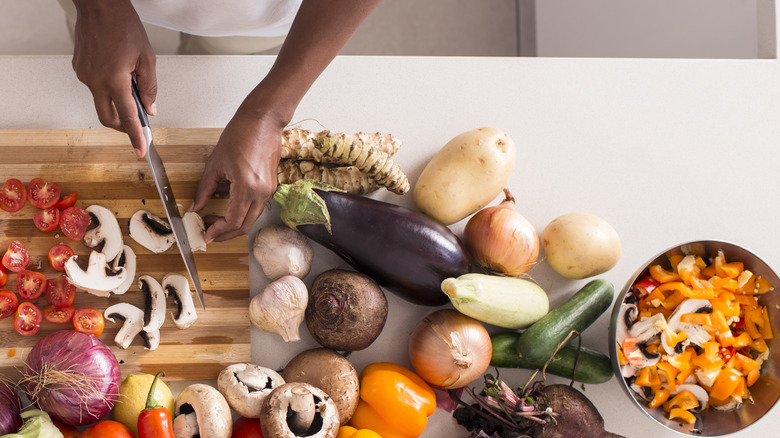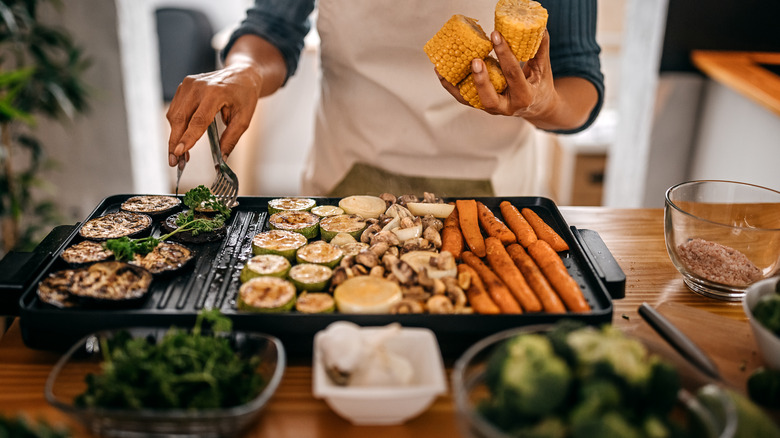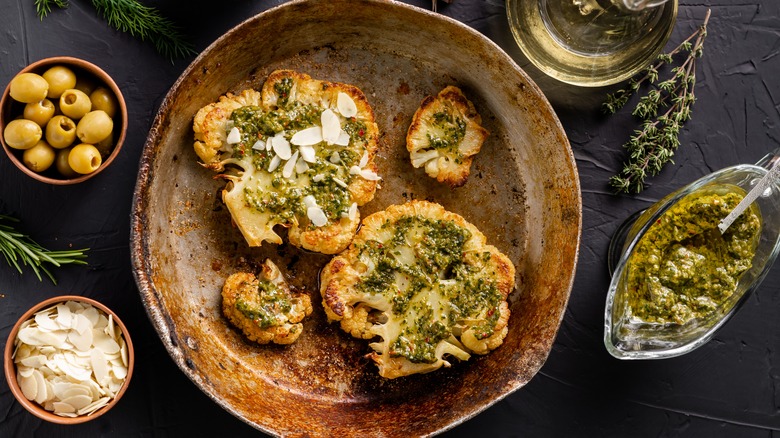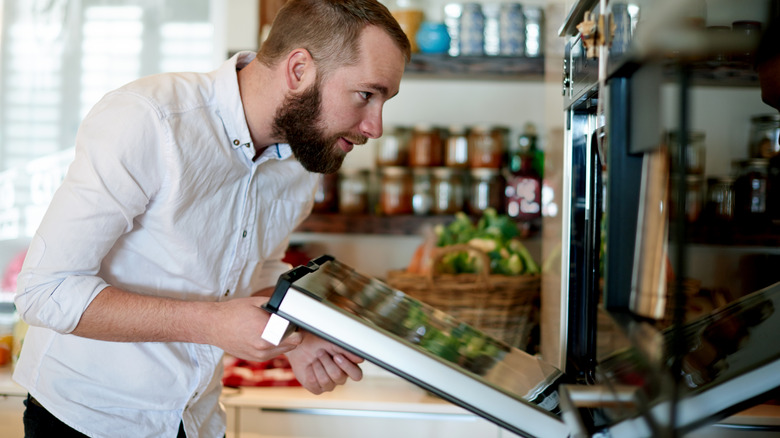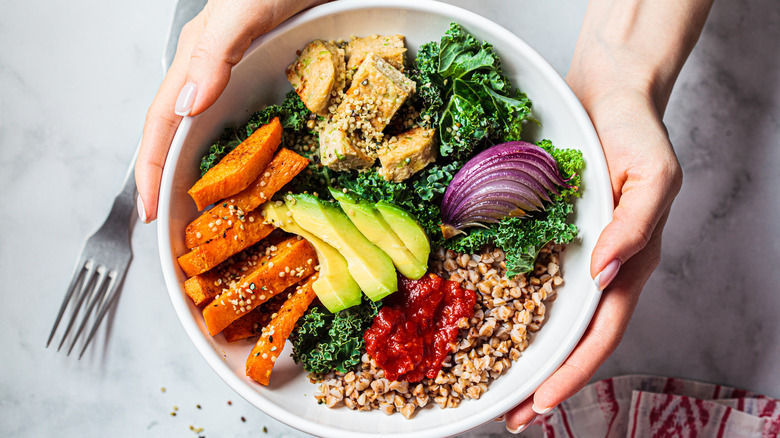16 Roasted Veggie Secrets You'll Wish You Already Knew
Whether you're fairly new to cooking roasted veggies or have been making them for years, you'll want to know all the secrets to help them reach their full potential. If you're ready to unlock some of the best flavor possibilities of those veggies collecting dust in your fridge, we challenge you to put them in a roasting pan. As they roast, all that caramelized flavor will take them to new heights. However, you need to know a few tricks before you get started to upgrade the flavor and ensure that your veggies brown to perfection.
We're always looking for ways to make our roasted veggies even better, so a little research as well as trial and error has helped us fine-tune our roasted veggie game over the years. With just a few secrets at your disposal, you can transform your vegetables from an ordinary side to the star of the dinner table.
1. Root veggies aren't the only veggies that taste good roasted
When you think of roasted veggies, you probably mainly think of root veggies. Root vegetables are yummy roasted, and they're what you often see at restaurants. However, you may be surprised to discover how delicious some other veggies are when roasted. Sometimes, roasting can bring out different flavors in veggies you dislike or barely tolerate and turn them into faves. There are some — like roasted cabbage and roasted beets — that we end up eating like candy off the roasting pan before it even gets to our plate.
Several categories of vegetables taste good roasted. Potatoes are nice, but you'll also enjoy root vegetables with sweet notes that become slightly caramelized and crisped during cooking, like carrots, beets, sweet potatoes, and parsnips. Cruciferous veggies like broccoli, cauliflower, Brussels sprouts, and cabbage are also delicious roasted and acquire delicious browned edges. Winter squashes like butternut and acorn beg to be roasted. There are also more delicate veggies that acquire a nice flavor when roasted, like asparagus, onions, tomatoes, zucchini, green beans, artichokes, peppers, and tomatoes.
2. You'll want to pay attention to the seasonings you use
Some people just add salt and pepper to their roasted veggies, expecting the flavor of the veggies to shine. However, we like our veggies a lot more when we add aromatics, herbs, spices, or other ingredients. The mix is up to you, but we suggest matching the flavors to the rest of your meal.
Some aromatics you can use include onions, garlic, shallots, leeks, and ginger. These ingredients roast with your veggies and help improve the flavor. Powdered versions like garlic powder and onion powder work well, too. Fresh herbs are another option. Some that pair well with roasted veggies include rosemary, thyme, oregano, sage, parsley, and bay leaves. Jamie Oliver suggests not adding herbs until halfway through baking so they don't burn. Plus, doing this provides "much more of a perfume of the herbs" (via YouTube). There are tons of spice options too. Common additions include paprika, chili powder, red chile flakes, cumin, and even curry powder. Some sweeter veggies like squashes and sweet potatoes pair nicely with warming spices like cinnamon, nutmeg, cloves, and allspice.
Don't stop with the basics. You can try other ways to season your vegetables, like coating them with pesto, sprinkling them with shredded cheese (especially hard cheeses like parmesan), or drizzling them with honey.
3. A dash of tartness can seriously upgrade roasted veggies
Roasting brings out the natural sweetness in veggies, and adding an acidic or tart flavor helps balance the sweetness and sharpen the overall flavor profile. There are several options for providing tartness for your veggies.
One option is to add your favorite vinegar. Jamie Oliver adds a splash of vinegar to his roasted potatoes. He says, "The vinegar will totally cook away, but it's going to give the potato like a kick" (via YouTube). Balsamic vinegar is common for roasting veggies because it's somewhat sweet, matching the sweetness of the roasted ingredients.
However, if you're nervous about vinegar making the veggies too sour, there are some more subtle options to add tartness. Lemon or lime juice or zest can add both zing and a nice citrus flavor to your veggies. We also like to use sumac, which adds a bit of a bite without imparting a vinegar or citrus flavor.
4. Oil is your friend
When you add your seasonings, you'll also want to add oil. Not only will the oil help to crisp the veggies, but it will help the seasonings stick better. You'll want to coat the veggies with the oil before seasoning the veggies (or add the seasonings directly to the oil).
When it comes to which type of oil to use, you'll want to choose one that will enhance the flavor of your dish. However, you'll also want to consider the oil's smoke point. After all, you want the veggies to roast rather than burn. Some good options are ghee, sunflower oil, and refined coconut oil, which all have a smoke point of 450 degrees Fahrenheit. If you want to use olive oil, consider using light olive oil with a smoke point of 465 degrees Fahrenheit instead of extra virgin olive oil with a smoke point of 325 to 375 degrees Fahrenheit. You'll find a similar problem with unrefined or extra virgin coconut oil since it has a smoke point of 350 degrees Fahrenheit.
5. There's a way to give your veggies a super crispy exterior
We don't know about you, but one of the best parts of eating roasted veggies for us is the fact that they get crisp without frying. There's nothing more disappointing than pulling your veggies out of the oven only to find that they're simply soft rather than being browned and crisped. Sure, you can pop them under the broiler for a few minutes, but that's likely not quite the experience you were hoping for. Instead, there's a secret ingredient you'll want to use: cornstarch.
Cornstarch can help make roasted vegetables satisfyingly crispy on the outside. To achieve this effect, start by ensuring all your veggies are dry. Then, toss your veggies with any oil and spices you plan to use. Finally, toss and coat the veggies with a tablespoon of cornstarch for every pound of veggies you're roasting.
As long as you start with dry veggies, the cornstarch shouldn't clump, so, you won't even be able to detect the starch on the outside like you would if you added something like wheat flour.
6. There's an ideal temperature for roasting veggies
If you've perused roasted veggie recipes, you've likely encountered a variety of suggested temperatures, ranging from low and slow to high and rapid. However, there's an ideal temperature for roasting.
Roasting even as low as 250 degrees Fahrenheit will caramelize food. However, through trial and error, we've found that the ideal temperature for roasting veggies is usually 450 degrees Fahrenheit. At this temperature, they have lovely caramelized and browned outsides and cook in a more reasonable amount of time without being too mushy. Plus, they also have a better flavor.
However, there may be times when you want slightly different results. For example, if you want your vegetable to remain somewhat crisp rather than soft inside, you can roast at 500 degrees Fahrenheit for less time. You may also want to take the temperature down to 400 degrees Fahrenheit if you're roasting whole veggies or larger chunks so that they don't get too brown before they're done.
7. You'll want to roast it in the right type of bakeware
When you're preparing to roast veggies, choosing the right type of dish matters. You'll not only need to decide between metal or glass bakeware, but you'll also need to pay attention to the size and height of the container.
First of all, you'll want to use a metal pan instead of a glass dish. Glass casserole dishes work fine for casseroles since you're usually only heating them to around 350 degrees Fahrenheit. Some glass dishes may be rated for up to 425 degrees Fahrenheit, but we wouldn't push it beyond that temperature. When a glass dish reaches its temperature limit it can potentially shatter, leaving an oven full of broken glass and misplaced veggies. Having experienced that mayhem, we suggest staying on the safe side and using a metal pan instead.
You'll also want to use a pan with a shallow rim. The higher the rim, the more your pan will reflect any evaporating moisture back onto the veggies, causing them to steam when you'd prefer them to crisp and brown.
8. There's a way to make cleanup easier
One of the most dreaded parts about roasting veggies is cleaning the pan afterward. Many dishwashers aren't up to the task. However, there's no reason you have to resort to scrubbing your pan by hand if you prep your pan first.
We suggest cutting a piece of parchment paper or foil to fit the bottom of the pan. When the veggies are done, you only have to remove the soiled parchment paper or foil and toss it in the garbage for cleanup. Most parchment paper is rated for oven temperatures between 420 and 450 degrees Fahrenheit, so you don't need to worry about it burning at the temperatures you need for roasting.
Whether you use parchment paper or foil is up to you. When Milk Street tested to see which would work best for roasted veggies, it found that parchment was more non-stick than foil and that a bare pan led to slightly better browning than one lined with parchment or foil. We usually choose the quick cleanup option, even if it means a touch less browning.
9. You might try hard roasting
One technique that is fun to try and delivers gorgeous and tasty results is hard roasting. It's one of the best ways to attain roasted veggie perfection if you don't have a convection oven.
With hard roasting, you place your roasting pan directly on the bottom floor of the oven. This method won't work in an oven with a heating element on the bottom rather than a solid floor. But if you do have an empty oven floor, give this method a try. It's akin to sauteing your veggies inside the oven since your roasting pan is directly touching a heat source, much as it would on the stovetop.
Like with stovetop sauteeing, you'll need to have fat in the pan with your sliced vegetables before placing it on the bottom of your preheated oven. You will also need to turn everything over every 5 to 10 minutes to brown evenly on all sides. When done, they'll be perfectly soft on the inside and roasty toasty on the outside.
10. Size and spacing matter
Size and spacing are important when it comes to roasting veggies. These elements determine how quickly they cook, how brown they can get, and how uniformly they cook.
If you want veggies that all get done at the same time without some being burned to a crisp and others being undercooked and unbrowned, you'll want to ensure the pieces are as close to the same size as possible. Bell peppers and fat root veggies like beets and potatoes should be in 3/4-inch pieces. You should cut long root veggies like carrots and cruciferous veggies like broccoli in half lengthwise and then into 1.5-inch slices. Cut onions in half and then into fourths. Meanwhile, you can keep cherry tomatoes whole.
Something else to watch is how closely you space your ingredients. Ingredients that are touching each other will tend to stay soft rather than brown. If they're too close, they'll end up steaming in each other's evaporating liquids instead of roasting.
11. You'll want to flip and turn your veggies
For a nice browned outer crust on your roasted veggies, flipping and turning is key. If you forget to flip and turn, you'll likely end up with an unevenly cooked end product. Just set a timer for the halfway point to move the veggies around and then another for when they should be done.
If you've noticed that your oven doesn't bake evenly, you'll also want to rotate the roasting pan a full 180 degrees in the oven halfway through the cooking time to give all the ingredients a fair chance. If you're making more than one pan at once, you'll also want to switch the pans' positions in the oven halfway through the cooking time, moving the pan that's in the upper position to the lower position and vice versa. At the same time, you'll want to flip the vegetables over inside the pan so both sides brown fairly evenly.
12. There are some ways to save time when roasting veggies
There are several ways to save time while roasting veggies. Chopping veggies can be time-consuming, so why not chop them ahead of time or buy them pre-chopped? Many supermarkets have pre-chopped raw veggies ready to go in the produce department. Even if you're a pro at chopping, peeling vegetables can take a long time. With so many vitamins and nutrients in the peels, it's best to leave most veggies unpeeled anyway. They will add not only to the nutritional content but also to the flavor. You'll just want to wash them well to remove any residual chemicals or dirt.
A trick for roasting veggies faster is to start them off on a preheated pan. With the pan already hot, they'll start searing the moment they hit the hot metal. Just place the pan in the oven when you start prepping your veggies, and it'll be nice and hot when you're ready to cook.
13. Different veggies require different roasting times
One time doesn't fit all for roasting. Keeping this in mind, you may want to roast in stages if you're combining various vegetables that need different cooking times. Put ones that need longer in the oven first, and then add more ingredients to the roasting pan in shifts to accommodate different cooking times.
While roasting times for vegetables vary depending on the temperature of your oven and the size of your veggie pieces, here are some good ballpark estimates. Sweet potatoes and Brussels sprouts need 35 minutes to roast, while regular potatoes and tomatoes do best with 30 minutes. You'll want to plan around 25 minutes to roast winter squashes, parsnips, eggplants, and cabbage. Meanwhile, carrots, broccoli, cauliflower, and green beans require about 20 minutes in the oven. Bell peppers and onions only need 15 minutes to cook, whereas okra requires only 12 minutes. Amazingly, snap peas, zucchini, and summer squash need a mere 10 minutes to roast.
14. Don't forget to add a finisher
Oil, herbs, and spices aren't the only ways to flavor roasted veggies. We also suggest using a finisher after you remove them from the oven. While it's not completely necessary, you can use a finisher to make an ordinary dish a little more fancy and flavorful.
Roasted veggie finishers fall into several categories. One option is to add a flavorful oil with a low smoke point that you couldn't use for roasting, like sesame oil. Something crunchy like nuts, bread crumbs, or fried onions can add an interesting texture. You could also make the dish spicy with hot sauce or sweet with an ingredient like honey. If you're looking for a more savory finish, consider adding shredded cheese, a sauce like pesto, a sprinkling of meat like crumbled bacon, or a dash of soy sauce. If you want an acidic kick that doesn't cook away, add your vinegar, citrus juice, or sumac after, rather than during, cooking. And to layer fresh flavors with roasted, opt for fresh herbs, such as cilantro or chives.
15. There are ways to reheat roasted veggies so they're still crisp
If you've ever eaten reheated roasted veggies that were a soggy mess, you might reject the idea of roasted veggie leftovers altogether. However, there are a few ways to reheat them so they're crisp and possibly even better than the original.
When Pantry and Larder tested several methods of reheating roasted veggies, it found that it's best to avoid using the microwave since it yields soggy results. However, every other method offered veggies with satisfying crispness. Your roasted vegetables will Iikely already have enough oil on them to not need any extra for reheating. You can reheat them in a skillet for three to four minutes, a 375-degree Fahrenheit air fryer for two to three minutes, or a 400-degree Fahrenheit oven for four to six minutes. You can even reheat them on the grill, turning them in 30- to 60-second intervals.
16. Roasted veggies can help upgrade many dishes
Roasted veggies aren't just for side dishes. You can integrate them into a variety of other recipes as well. So, next time you roast up a huge batch of veggies and have leftovers, consider repurposing them elsewhere. You might roast veggies for the express purpose of upgrading dishes in the future.
Breakfast is the first place where roasted vegetables are a great addition. Consider using them for egg dishes like omelets or adding them into the mix for frittatas. They can even be an ingredient in smoothies.
Beyond breakfast, they're great in a variety of salads. They can improve the flavor of green salads, and you can add them to grain-based salads and pasta salads as well. They will work in a variety of Mexican dishes from tacos to burritos. They can also make a great add-in option for many types of grain bowls.
